Share this
The last time I spoke to Laust, was back in 2022, which you can read more about HERE. Since then he has only become more renowned worldwide and continued to grow as an artist. So… seeing that it had been a couple of years, we started to pick up a conversation, and Laust invited me to talk at his studio. A huge space, a stone-throw away from the center of Svendborg, right next to the water, consisting of 200 square meters, with a kitchen, space for his kids to play, a lounge, various setups, and of course his paintings.
The following interview is a result of our conversation that day in his studio. But first, a more formal introduction, where his upcoming show “MASS MOMENTUM“, with Collaborations is also mentioned.
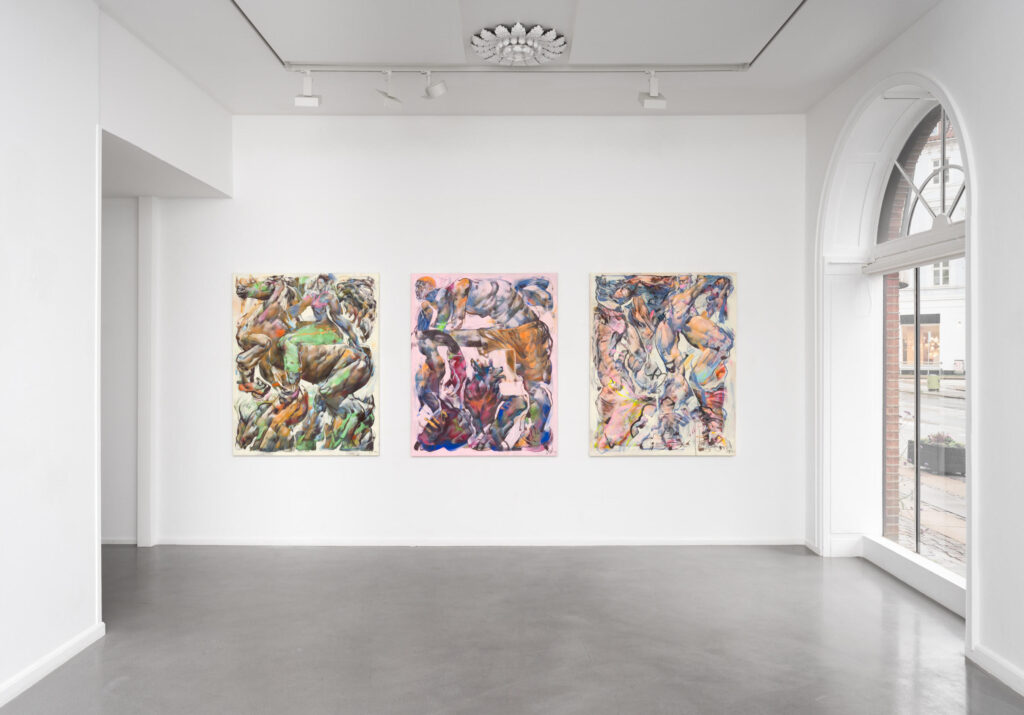
Through his expressive works, Laust Højgaard (b. 1989) reflects the world with humorous exaggeration and meticulous attention to detail.
Højgaard works impulsively, painting directly from his imagination onto canvas, often working on several paintings simultaneously. His curious characters emerge from an organic, abstract mass, evolving into angular figures, each with distinctive body language and details. To Højgaard, these characters represent quirky misfits, whose bodies are physically confined by the boundaries of the artwork. The geometric figures live in colourful, intricate boxes that also contain numerous references to mythology, pop and urban culture.
“MASS MOMENTUM”, is open from November 7, 2024, to January 2, 2025 at Collaborations, in Copenhagen.
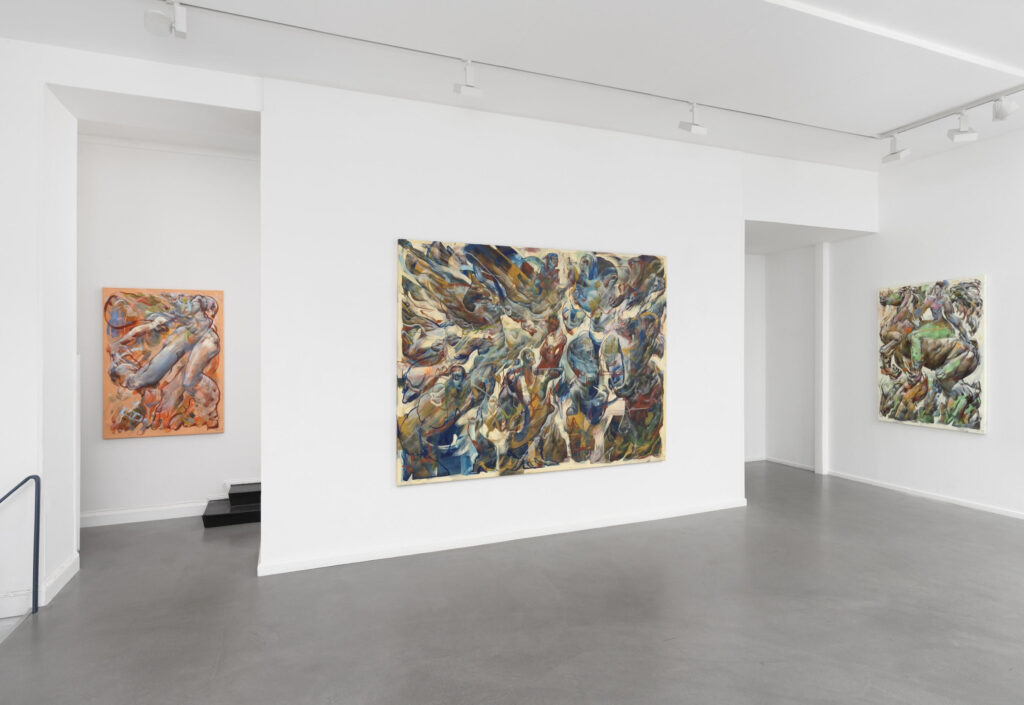
So the first question is as you know, how does a regular day look like for you, Svendborg.
Yeah exactly, I’m down here in the studio at nine o’clock, or something like that. I feel good in the morning in general, it’s where my head works best. I feel healthy, and I haven’t overthought anything. It’s also where I can work most intuitively.
That’s how I feel too, in the morning for me. It’s as if the mind hasn’t been filled with all sorts of things yet. It is as if you are a completely clean slate.
When I’m full of good energy, and I can give it all I’ve got. The days can be very different. But the optimal day, I just get a lot of paintings started, and I’ll take short breaks up here in the studio. It’s a long stretch. Not in a marathon way, but just like… Trying to keep myself from being too deep. And then in the afternoon, I’ll shut down. I’m talking about the rituals I have.
That thing we talked about with the adjustment, where I can’t just step out of the studio, into the real world again and meet people. I need to somehow land in some kind of no-man’s-land before. Just to readjust myself.
And also just to shut down the ideas properly, so that I can pick them up in the same place I left them. I feel like that might be kind of a fluffy answer, I don’t really know how to word it, I mean I drink coffee and eat food when I’m not painting. But otherwise, that’s what I’m after.
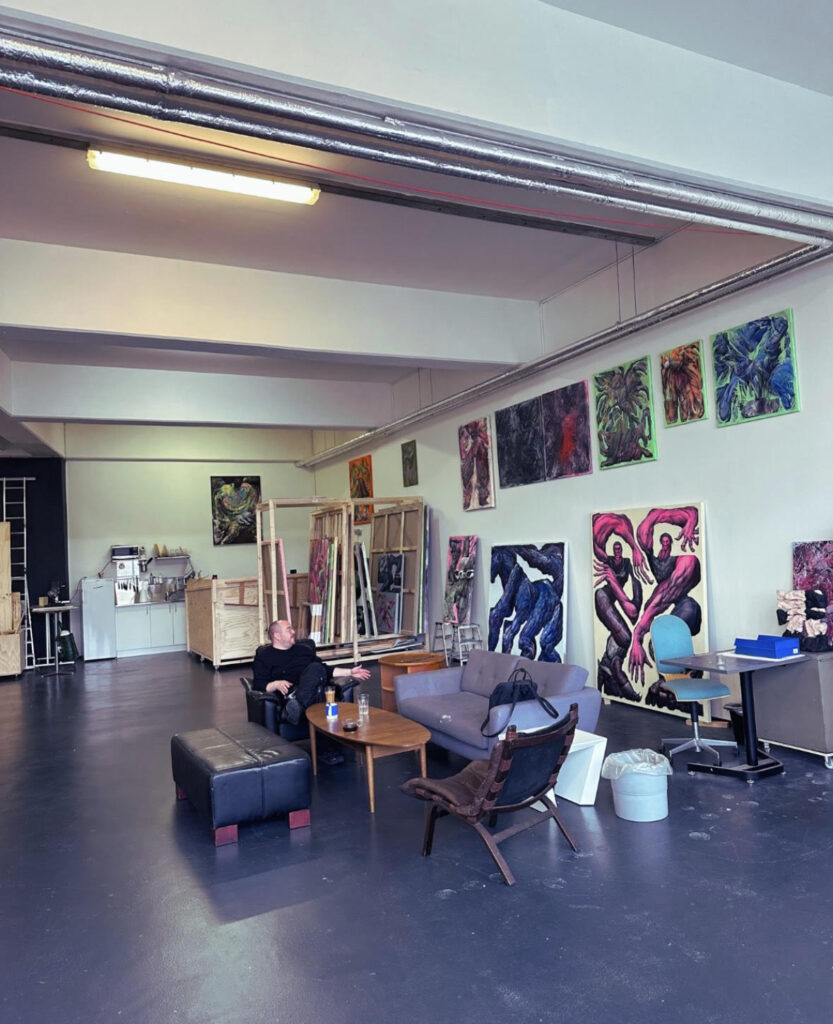
It makes a lot of sense, the thing about having some kind of no-mans-land where you step out of your “bubble” of creativity correctly, to disconnect and be normal.
Yes… I can get used to that… I need to look at my things after I leave them and exit correctly. I think it’s hard to stress about something I have to do or an appointment somewhere, and then just shut down everything im working on, right that second, and then tumble out the door.
I mean, It just doesn’t work for me that way. The idea’s doesn’t continue to evolve in my head if I exit that way, and I wan’t be able to continue where I left it the next day. Then I associate the ideas with something that has been hectic. So it has to be like this… You have to say goodbye properly. it must feel good, because then it also feels good entering the studio the next day.
I also don’t want to feel like I might have missed out, and come home and think, ugh, I should have done this. So yeah, setting limits can be rough when I work creatively. But I feel that I have to set some rules for myself, because I can’t just stay up here for three days straight. Then I’ll go crazy. So it’s about setting some limits, and then leave the right way, and kind of grow within it.
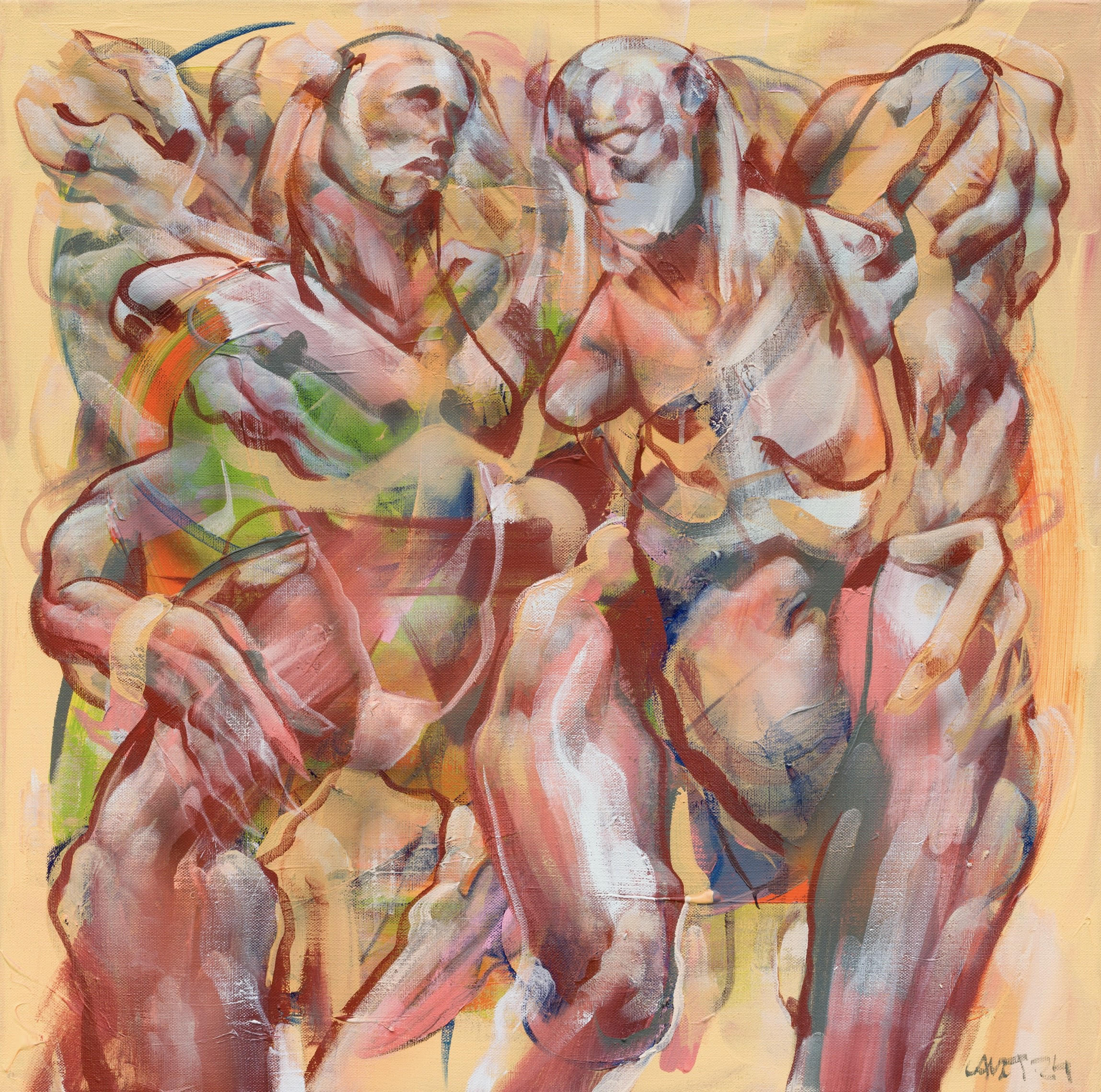
What if, for example, you have the day off, with nothing on the schedule?
Well, I think iv’e come to terms with this. Thinking about doing something creative, even when I’m off. The noose can get tightened, because then the result will be better in the end. If I have painted many days in a row, I can get a day where I feel like, ok, now my battery is low, creatively. Where earlier I might have felt frustrated about not being able to paint enough.
So I’ve gotten better at knowing that I need all of the above, so that the right thing comes out, and for the interesting work to be created. So I have to do other things, other wise I crash.

Okay, but let’s say It’s Sunday, and you have promised to be home all day. What do you do for example?
Then I want it to be about everything that’s not work related, and we’ll enjoy ourselves with our children. But I will also handle my emails and invoices, all the boring office work stuff. If I’m in my studio, that’s my safe space.
Okay, so… Last time we spoke was in 2022. What have you been up to since then?
Since then I’ve had my solo in Paris. And in Berlin. And a lot of group exhibitions, as well as worked with some galleries. Some larger galleries, like The Hole in New York, and huge galleries like Stems in Brussels. And then quite a bit with Gallery Droste of course. Oh, and my works have become bigger and more pompous. I feel like, everything has somehow intensified and become wilder. I feel that I work more intuitively. More true to my temperament.
And yes, I also feel like we talked about, this thing about me zigzagging a bit in my processes. In other words, with the fact that I explore these nooks and crannies of my own style and my own expression. Out in some completely abstract ramifications sometimes. And out in some almost minimalistic nooks and crannies. Then I can have periods when I am in two places at the same time, and then I kind of get back on track.
But I constantly feel that I am moving forward. And I kind of borrow these nooks and crannies and I feel like I’m moving further and further out and exploring more and coming back with things I’ve borrowed. It’s an insanely exciting process.
So, yeah, It’s a bit of a mental trip-like feeling, which is really rewarding. And again, it’s definitely just paying attention to what I’m curious about. I’m not going to look for the perfect, or what symbolizes what is right. I have to look at my curiosity, that’s where the best things come from. That’s where the good expression comes in, and what’s interesting for me to do, and what I then also believe is interesting for others to see.
I mean, it’s clear, it’s the brain right? Then you move on to new leads and things like that, which is fine. It’s very natural. I like that very much. So, it’s like it just takes a natural course. It takes its own course, you know.

I feel you. I gotta ask you this, and I always ask this because I’m fucking curious, but… what were you like as a kid growing up?
I was kind of withdrawn, some might say quiet. I was the one who always sat and immersed myself in drawing typically. So… To one degree or another, probably also something of an introvert. I guess you could say it’s in many ways the same way as I am now. This thing about me needing to enjoy time for myself. Time to digest everything. And then I could kind of step out into the world and take part. But yeah, back then I needed breaks, and I still do.
So, for example, how do you feel about big exhibitions, or big shows around the world? Events? Like Art Basel for example?
I think it’s cool, because it’s also there that my work comes to life. But it’s not something I could do every day.

When all the focus is on you and your work, are you ok with that?
Yes, well, I think so actually. I think we talked about that earlier, this thing about it’s my works that’s in focus. It’s less me. It’s a product of who I am and what I’ve chosen for them to see and what I’ve worked on. So… Of course you represent your work, but the focus is on the work, and I actually like that.
My work is some sort of examination of my own head, and I find that interesting, so it’s also interesting to talk about it with others. What they experience and what they get out of it.
Okay, so you’re fine with it, as long as it’s in small doses.
As long as I get some breaks, then I think it’s cool. My work has to get out of the studio to live. I want it to go out and live. After all, I want it to hang on peoples walls, physically, and for people to come and explore the same thing I’ve explored.

I think I’ve noticed, and forgive me if I’m wrong, but has your style changed a bit during this year?
I don’t really know if anything has changed, but I feel like it’s at least expanded and evolved. I see my work as some form if organic mass. A three dimensional mass, that can be anything.
Typically, my work centers around organic beings and figures, but I’ve realized it doesn’t have to be limited to just that. The material can expand in various ways—it can be dense, light, or even porous. Through this exploration, I’ve discovered that my motifs emerge from this adaptable mass, allowing them to take on diverse forms.

Yes, because you’re known for figurative paintings. But this up here (points to the wall), looks completely different.
Yes, but I think it’s a matter of embracing the abstract. It’s one of those areas where things become less defined. While it’s still a physical form—perhaps a close-up of something or a lump, or even a mass—it’s more abstract, and it resembles the forms my work often revolves around.
So, I’m definitely in this abstract space, but I’m also finding ways to bring what I explore there back into my figurative work, which still feels fundamentally mine. It’s like a kind of DNA, the core of my artistic identity that underpins everything.
In a way, it’s about pushing beyond my comfort zone and borrowing new ideas from there. This exploration is vital; it’s what keeps me evolving as an artist. The worst thing that could happen is boredom, but I’m lucky to rarely feel that because I try to follow my curiosities and let them lead me.
I’m experimenting with different techniques too. I’m using brushstrokes more actively now, letting the brush marks stand out more than I did a few years ago. There’s something about combining these marks with this organic mass that creates direction and movement in a fresh way, blending the two elements.
I get why some people might feel that my style has changed, but really, it’s just this sense of expansion that I’m following. At least, that’s how it feels to me.
Okay. So there are more tools to pick from?
Yes there is. But it’s the same universe I’m constantly residing in. But luckily, it’s expanding.
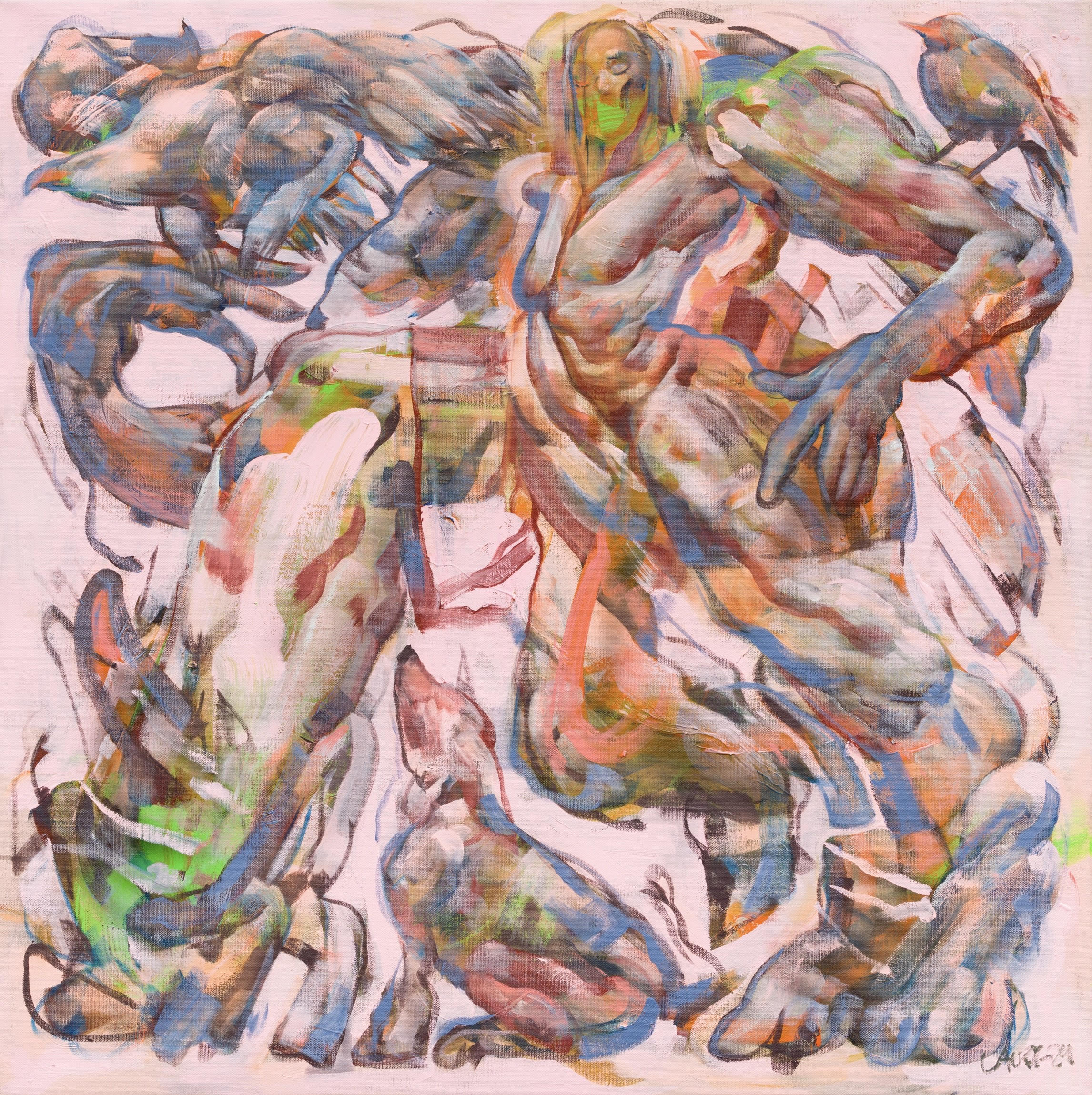
Ok, this next question is a more lighthearted fun question. If you lived in a parallel world to this one, who would you be and what would you be doing?
I think I would be doing some form of artistic expression. Whether it was music or something else, I feel better when that creative part of me comes out, so it would come out one way or another.
I also like to build things. I like to shape things. So it could also be something more like that…. Craftsmanship of some kind. Although I have played a lot of music in the past, now it’s narrowed down to become something visual. It’s what I’ve always been most attracted to. But I feel that there is a lot of my work that I can translate into what I like about music.
I believe the intuitive, raw, and one-take quality in my work aligns with many artists. Where I feel there’s a natural match with their creative universe, I can see a strong, definitive visual connection. In that sense, I think this artistic expression feels closest to the essence of my work.
I also think that there is something to be said for reaching out and grabbing what is available. I remember I heard something with Christian Leth at one point, where he said saying that there was a piano in their home and there was music in their home. So if you have some urge to create something, you also take what is in the living room. And I think this visual thing, it’s always just been fucking easy to pick up a pencil and draw. I think I just found something that worked there. And then I just kept going at the time when others stopped.

Tell me about your creatures and figures… Did you start drawing them as a teenager, or when did you start bringing them to life?
No, I actually rummaged through some old drawings and stuff from when I was around 12, and I can easily see the same universe I’m in now. So, it’s… universe is such an easy word. But it is some kind of world. Well, at least it’s something that was created by some things that I was fascinated by back then, and still am fascinated by.
I’m drawn to things that decay, morph, and merge into each other—elements that hold a mix of melancholy, humor, grittiness, and even a bit of the artificial or post-apocalyptic. There’s something reminiscent of Warhammer’s low-culture aesthetic blended with grand, mythological elements like Greek statues and ancient creatures. Altogether, it fuses into a kind of smoldering mass, a lump of diverse references that meld together in unexpected ways.
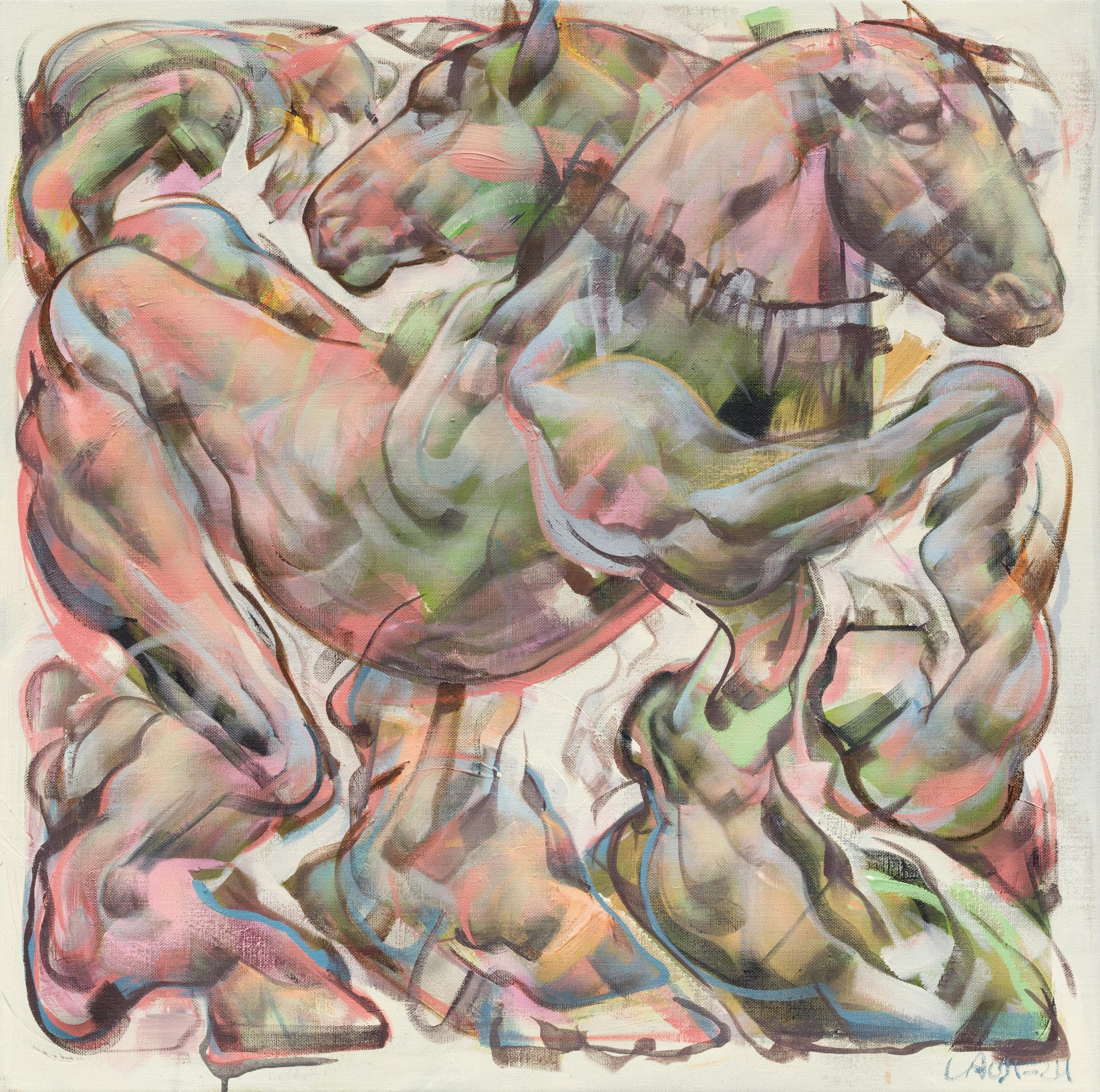
Do you remember when they started to take shape? When they started getting that recognizable look?
It’s been many years in the making, and then I’ve had a break from it, but I would say they started to take form when I was around 10, 11, 12 years old I think. And then it just became like this… I have become wiser about it. And I have become sharper at showing and exploring that feeling or urge to make it appear in a certain way.
The interesting this is, that you open, and open, and open, and open. You just build on, and on, and on, and on. And it is, in fact, the same thing that I explore in the works I create. I mean you just build layers on layers on layers, and it has it’s own way and it takes shape.

How does that feel to be able to live off your work?
I’m incredibly grateful for how fucking privileged I am. I also feel that I’ve invested a huge part of myself in my work. I’m just happy that I can put so much into this process, where something I’ve created emerges at the end. And that it enables me to keep doing it, over and over. I mean… I feel better. I have gotten better health from painting. It all starts with the mental, as they say. If you feel good mentally, then it will probably work out.
I don’t remember who I talked to, but I was fucking stressed for a while. That’s why I started painting again. My liver gave out. I got a severe liver disease and have had Coagulopathy for many years. I should have been on all kinds of crap meds. The day before I was to start the treatment, I had new tests taken, after I had been painting for a few months, and everything was gone. All the stress. Everything.
The experts I’ve spoken to say it’s simply environmental change. To reprioritize and do things that I enjoy doing. And as I feel I need to do. It’s just the biggest gain. This is also why it is rewarding on so many levels to have the opportunity to do this. It keeps me in top shape.

That makes sense. It all starts with the mental. Like if you have a bad mental state, it affects the whole body. Did you say it was your liver?
Yes, my liver and my blood. I have a blood disorder so my blood doesn’t clot.
This is why it is said that you can think yourself ill. And it’s really true, you can.
Yes, and I didn’t spend my time on things I enjoyed. I do that to a much greater extent now. And I can really feel that. So it feels good. That’s the point of it all.
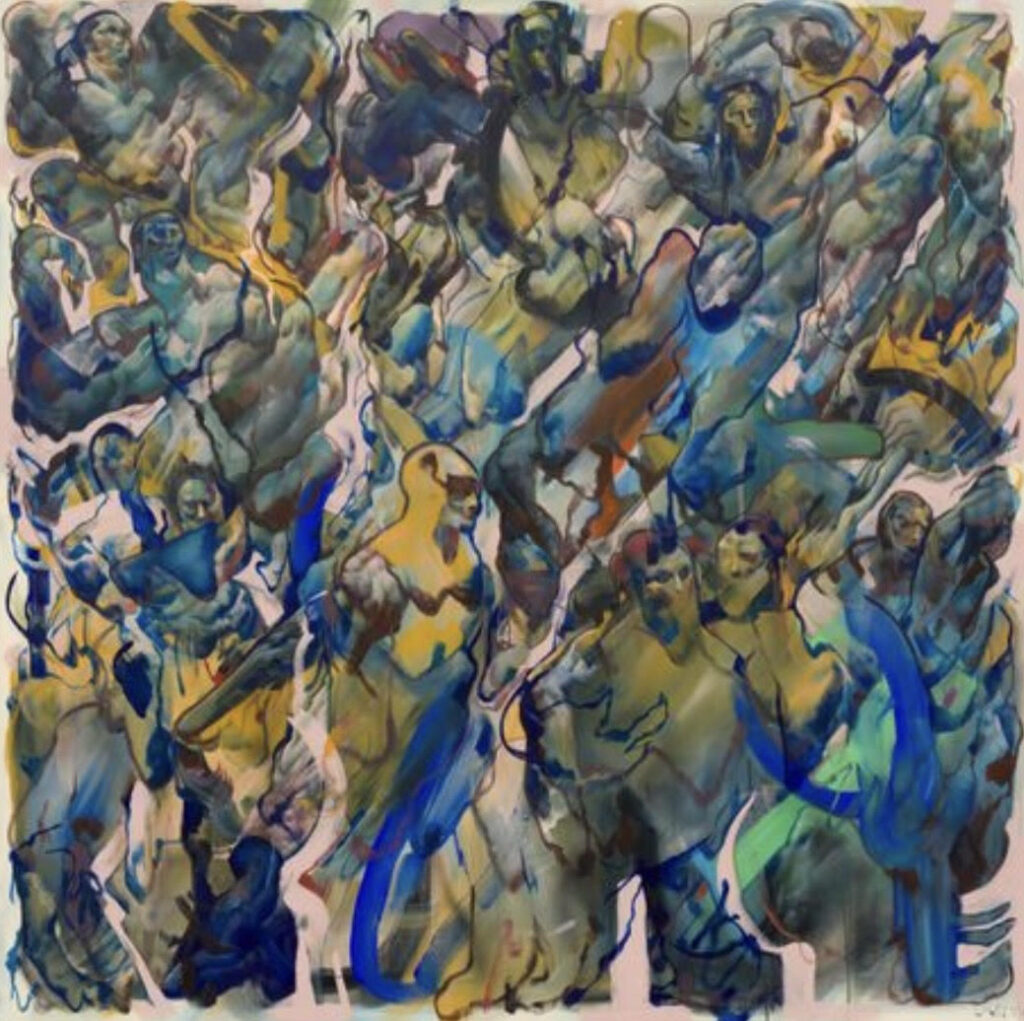
Switching topics…. Can you tell me about your use of symbolism?
Well, I use it a lot. I’m borrowing from the world of mythology. I’ve had a period when I was very much preoccupied with characters and scriptures. Everything from something ancient, Egyptian, and again references to Greek mythology and such. But also some much more modern ones… Or newer written language and symbols and such.
Hobo science and stuff…! Yeah, some hobos in the US who put marks and branded different places and objects. They have been traveling around and jumping on trains and stuff like that. And then in the villages, they have… Or in the cities in general, they have cut marks into the people’s railings or at a station and all sorts of places, and by doing that, they have communicated with others.
For example… you can get water here, or watch out for the guy who lives here, he has a gun and is aggressive. Or he has a dog. And then other hobos will be warned. Something like that… Again, something like low culture, where it’s fun to combine with these very historic big things we associate with. Something very grand. That kind of symbolism and what it can become when you throw it into the pot with everything else.
So yes, I use symbolism in my works. And how is it expressed? I would say that it is something that I use as references to in one way or another. And put an extra layer of narrative that personifies the characters I now create. In other words, in one way or another, give them something… Apply some meaning to them, which you can perceive not only and purely as an expression, but as a language. Or something like that… Arh, that last part was awful… It was just worth mentioning.
But that’s what creating some reference space is all about. And the contrasts between the magnificent and layered culture and such… How to incorporate it in some ways that merge with the rest and become abstract.
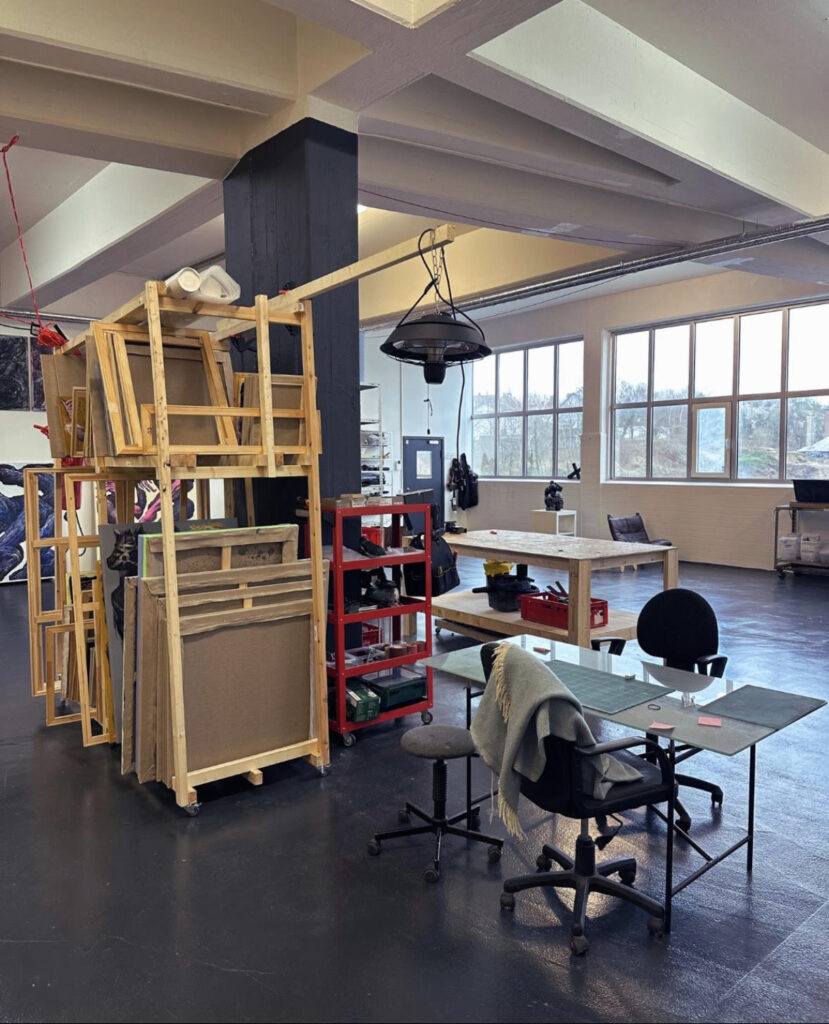
With that in mind. What’s your inspiration behind your paintings? And what do you hope that we, the observers take with us after viewing some of your works?
I hope to convey the same curiosity I’ve explored myself. I’m seeking a particular expression—a mix of spontaneity and the influences I’ve absorbed over time, along with the specific situation I was in while painting.
As a viewer, if you’re drawn to the work, it’s likely because you’re encountering my thought process and creative journey. My hope is to spark new thoughts in the audience, giving them something to build on in their own way
Again, the work should preferably open up. So, it doesn’t have to tell a completely clear story, or symbolize something that is obvious. It has to be up to the viewer somehow, and turn it into something that makes sense. So it’s not like there is one answer to it, there are many different answers in each work, hopefully. If that’s what people are for, at least that’s where I want them to go.
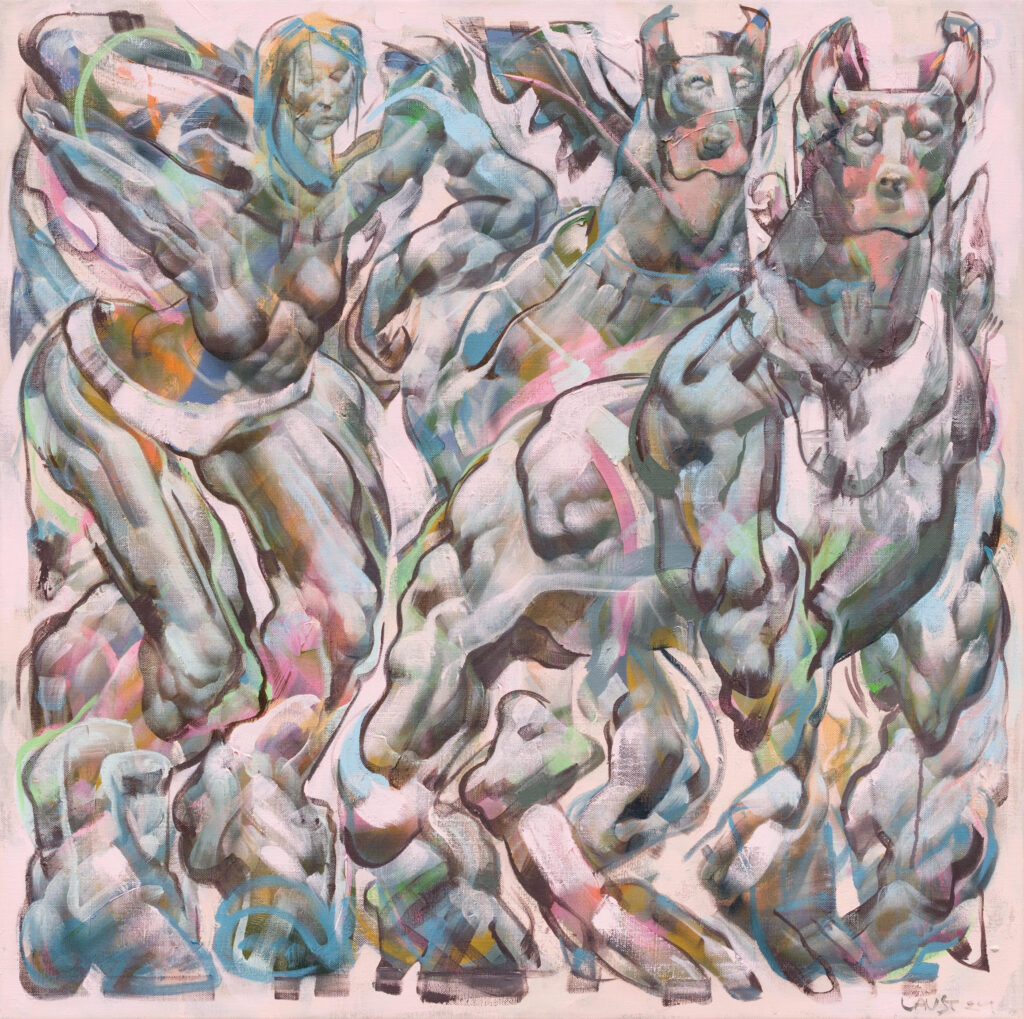
How about your creative process. Can you walk me through that, from beginning to end result?
I often begin very intuitively, usually by creating shapes directly on the canvas rather than working from sketches. I’m not aiming for a specific finished outcome; instead, I leave things open to develop on the canvas itself, free from any pre-defined end goal. I might start with a loose sense of direction, sketching in a rough way, but the piece always evolves into something different. In fact, I try to push it away from the original idea and allow it to take shape on its own.
The process starts out abstract and spontaneous. From there, I explore how the composition holds together—how the shapes interact and what feels powerful or resonant. Gradually, it becomes more focused and intentional, transforming from something wild and intuitive into something structured. And sometimes, unexpectedly, it opens up again as I go.
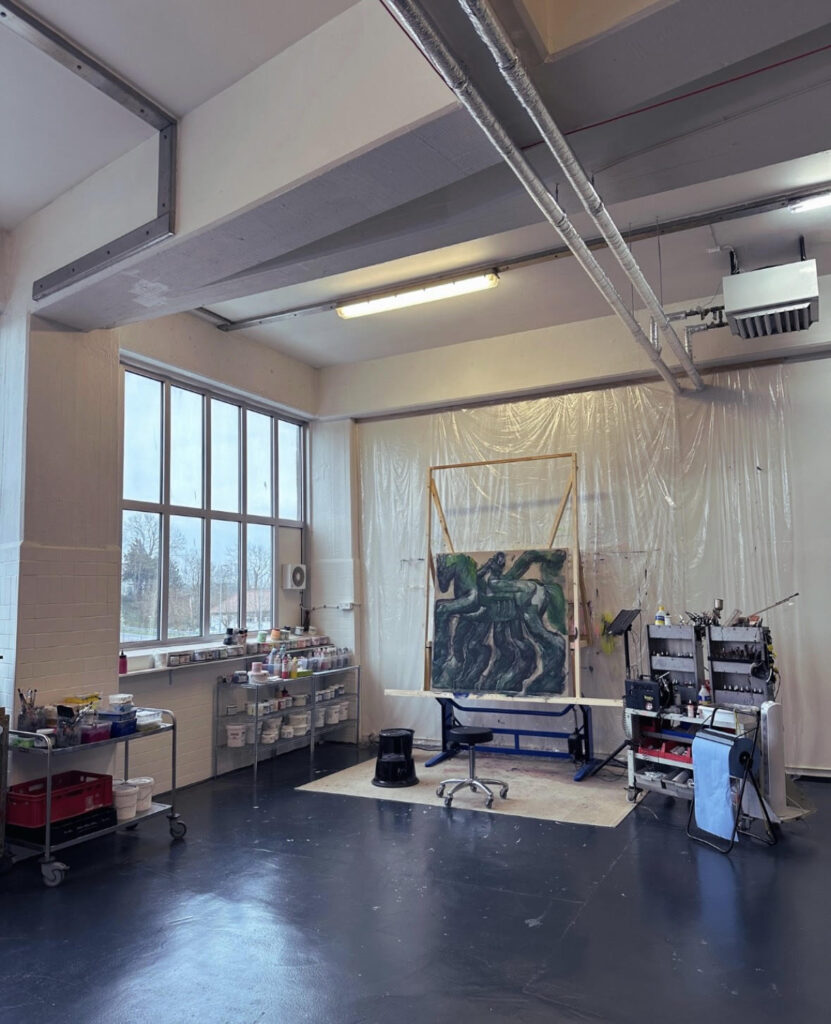
Let’s just take the horse over there as an example (Points at the canvas). When you started on it, did you start with some brushstrokes, without really knowing where you were going?
Yes, more or less. I started with this one, focusing on the heavy, rounded shape—something like the stomach, back, and haunches combined into a single form. I imagined it standing with one front leg raised in this slightly pompous stance, which I really liked. Originally, it didn’t have any defined paths or lines, and it may not end up with them either, but it began as this central, heavy shape that branched out across the rest of the canvas, evolving naturally.
I enjoyed how it embodied a mix of strength and majesty, yet also had a calm, almost subservient quality. There’s an interaction between this animal—this horse-like form—and a more human-like figure beside it. Together, they create a sense of tranquility and security that resonates between them somehow.

How do you deal with creative blocks?
I wouldn’t say that I’ve had a decidedly creative block, but I’m constantly trying to find new ways into my work. And It’s this thing again with following the curiosity, not thinking about end results. When I struggle to get started, I make myself dive in. I never let myself just sit and stare at a blank canvas, because that never sparks anything intuitive. If I did, I’d only feel more and more stuck.
It’s about laying down some initial strips and then often painting over everything or flipping the canvas upside down to create something new. I find it dangerous to get too caught up in reality. It’s important to be okay with producing a few crap works in a row because, in doing so, you’re processing something that will eventually lead to a breakthrough.
I actually think that would be my advice very briefly there. Just don’t stall. Don’t take any breaks during the day…. Something like that. I haven’t really been in that situation. I think I’ve found another way to attack it. And otherwise, if I’m not in the mood for it, then some canvases just need to be strung up once in a while. And that’s quite a lot of hard work, which I really appreciate quite a lot. So at least you’ve got some canvases up that day.
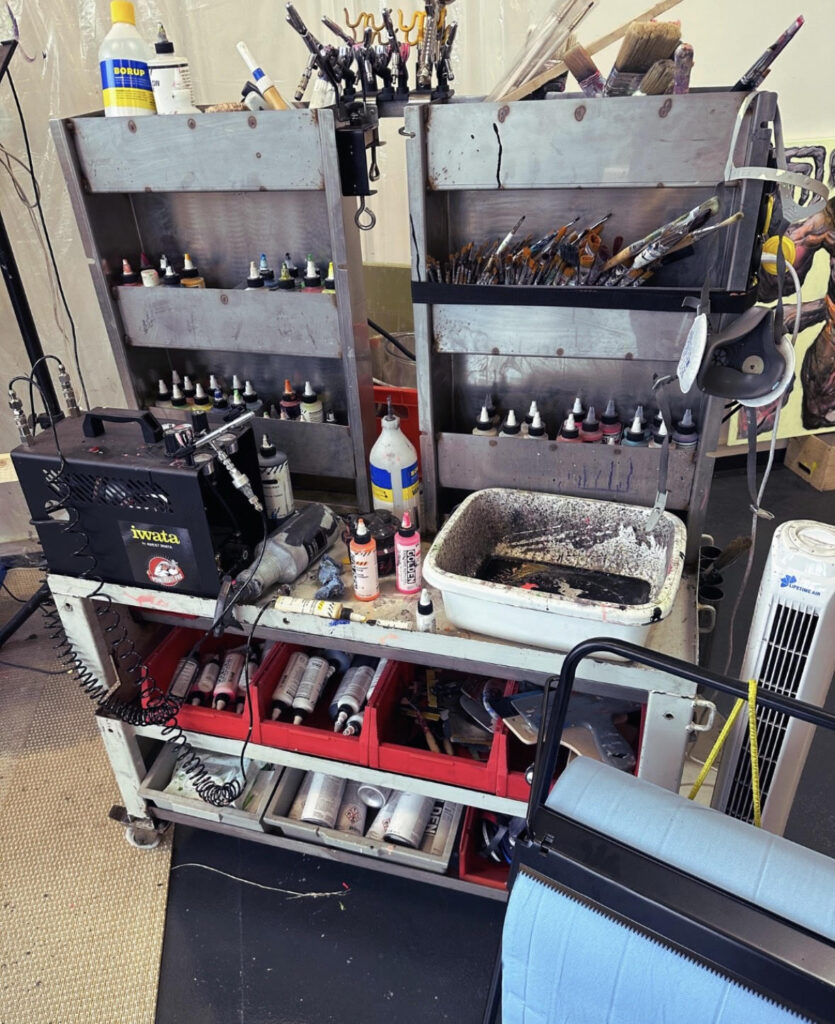
That’s true, sometimes it’s just about doing something. Then that can grab on to something else. How do you approach color? Do you have some kind of image in your head of what the colors should be from the start?
Yes I have. I’ve found that a good way to work for me, is to simply have lots of colors available close to me. Very easily accessible. I have my buckets ready in all colors. And then it should be really easy. And my brushes are close. It should be really easy for me to slap it up. See if it works.
If no, get another one and slap it up. See things in interaction. I know about subject-teaching. I have studied that. I’d rather do than think. I’d rather try it out to see if it works. Balance between things is not necessarily the goal. If it can provide some tension in some way. To use some colors that go against the rates. So I think it is important to create that tension and the good balance somehow

Your works have been exhibited all over the world. Do you have somekind of rituals before shows?
No. No I have not. No, I don’t actually have that.
Do you ever get nervous?
Yes I do. I’m always excited to see how things are received.
Isn’t it a bit nerve-wracking to be judged? What you’ve put so much time, sweat and tears and frustrations into, isn’t it a bit nerve-wrecking when it finally has to be judged by others?
Yes, it’s a bit nerve wrecking. But I feel like I’m getting better and better at being comfortable in knowing that I’ve made these decisions at a time that I feel is right. I guess I have to say that. But yes of course I fear that people want be able to see what’s in the work, the way I can see it. I don’t think I’ll care if it’s good or bad. That is my own observation. If people disagree, then that’s fair enough. But of course, it would be crap to make a whole show that nobody liked.
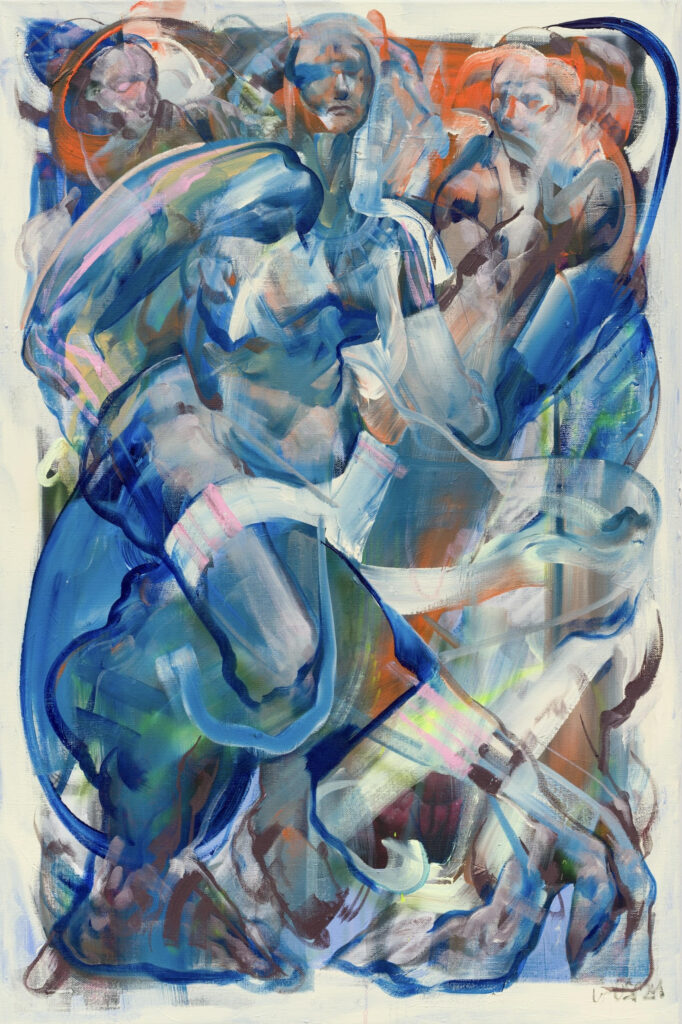
What I think I would fear the most was if I didn’t sell anything.
Yes, that would be a huge setback.
Because then I would probably start doubting the work, if it was even good. Know what I mean?
Yes, I believe you can create good art that also sells well. ‘Good art’ can be subjective, varying from person to person, and it can sell for different reasons. I think presentation plays a significant role. I feel that what I’ve created is genuine, and if it doesn’t sell, it might be due to how it’s presented rather than the quality of the work itself.
There will always be people who thinks that what I do is shit, but fortunately, there are many who appreciate it as well. I believe that as long as you’re not trying to please everyone, your work remains authentic. There’s often a certain tension or energy that can attract interest, and that’s all it takes for someone to find it compelling.

There’s a saying, that if you are friends with everybody then you are friends with nobody.
I think it’s like Ruth Evensen, in that saying she has, where she says you should never be lukewarm. (Points at the speaker) I listen to that, I listen to that over there on the speaker.
(The next 5 minutes consists of us talking about out excitement about a podcast called “Third Ear”, where the topic is a christian-cult called “Faderhuset”, and the leaders name is Ruth Evensen.)
Ok, back to the interview… What motivates you?
Well, my curiosity. No, that’s just such a boring answer, isn’t it?
No, it’s the same with me. So how would you describe a perfect day?
A day where I am constantly surprised in my processes. Something cool will come out of it. When something unexpected happens on the canvas. Where I feel that I have captured something that I didn’t even know I was aiming for.
That is what I hunt for. It leads, I hunt.

And you’ve started sculpting. How did you get introduced to that? And why do you like to express yourself through that?
Well, I think in one way or another, it is very close to my way of painting. Because I see my subjects quite a lot as these organic forms.
It’s something I’ve been thinking about for a long time. It’s just really interesting to try to turn it into. My motifs, I imagine exactly how the whole shape and all these figures and characters, what shapes they have all around. There are some other materials that I can discover and see those forms in a different way. With lyre or bronze. It’s really satisfying to see how it adapts. You can touch it, you can put it in places. It’s something completely different. It becomes a little more lively in a way.
And then again this thing with the fact that it stems a bit from this idea that it’s just a mass that I work with. So in my paintings, I define this mass in something two-dimensional, but I still imagine it as a mass that I can modulate. So it really doesn’t make a big difference whether it’s shown on a canvas or whether it’s a sculpture.
I’m excited to discover and explore even more. Speaking of delving into the details, I believe there’s a wealth of inspiration in sculpture that I can draw from—techniques and processes that I can translate onto the canvas and vice versa. It’s all about expanding the universe I work within.

You touched on this a little bit earlier. But in another interview you did, you mention that a few years ago you took a long break because the expectations got too high. And since then you’ve only become more recognized in the art world. Do you still feel like this sometimes? And how do you deal with pressure and expectations now?
I’ve realized that it’s never been other people’s expectations that have stifled me; rather, it’s been the pressure I’ve placed on myself.
You mentioned perfectionism earlier, and I think I’ve moved past that mindset. The idea of creating a perfect, complete work and feeling compelled to achieve it has become clear to me—it’s not just unrealistic, but also boring. I wouldn’t even find it interesting to look at.
Chasing perfection isn’t worthwhile because it leads to something stiff and overly finished, and that just doesn’t resonate with me. Those expectations were ones I built around myself regarding how my work should be. If I don’t find it exciting, then it doesn’t matter. Ultimately, these were my own expectations, not those of others.
How about pressure, for example… Do you deal with pressure the same way?
I realize that when I feel pressure building, I need to pause and step back from what I’m doing. I can’t have that kind of pressure in my work, it turns things to shit. I believe it’s my responsibility to manage these situations, as no one else can do it for me.
While galleries do offer support, I’m very mindful of navigating these scenarios. They can be significant stumbling blocks for me.
You have also said that you feel much better mentally now. And you have the freedom to do what you want…
Yes, and I basically never do commissioned work, because it doesn’t become interesting in the same way, because the process is completely turned upside down by it. It may well be that people have an idea that I want to make something specifically for them, but that ruins the process. As long as I am privileged enough to create, again based on my own curiosity, then that is what I have to do.
Laust’s newest solo show “MASS MOMENTUM“, will be open from November 7, 2024, to January 2, 2025 at Collaborations, in Copenhagen.
